HNBS 310 Financial accounting
VerifiedAdded on 2023/01/06
|24
|4585
|47
AI Summary
Contribute Materials
Your contribution can guide someone’s learning journey. Share your
documents today.

Financial Accounting
Secure Best Marks with AI Grader
Need help grading? Try our AI Grader for instant feedback on your assignments.

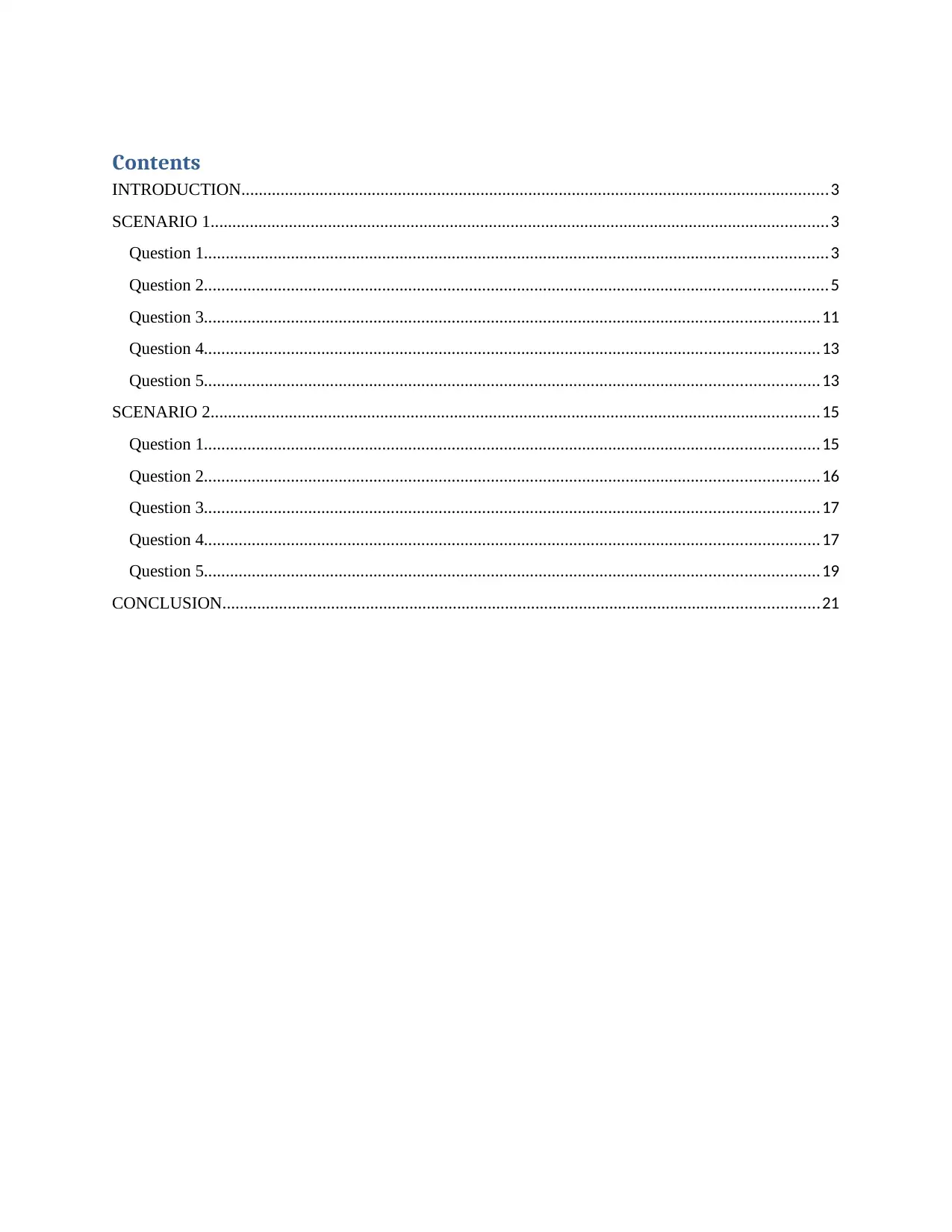
Contents
INTRODUCTION.......................................................................................................................................3
SCENARIO 1..............................................................................................................................................3
Question 1...............................................................................................................................................3
Question 2...............................................................................................................................................5
Question 3.............................................................................................................................................11
Question 4.............................................................................................................................................13
Question 5.............................................................................................................................................13
SCENARIO 2............................................................................................................................................15
Question 1.............................................................................................................................................15
Question 2.............................................................................................................................................16
Question 3.............................................................................................................................................17
Question 4.............................................................................................................................................17
Question 5.............................................................................................................................................19
CONCLUSION.........................................................................................................................................21
INTRODUCTION.......................................................................................................................................3
SCENARIO 1..............................................................................................................................................3
Question 1...............................................................................................................................................3
Question 2...............................................................................................................................................5
Question 3.............................................................................................................................................11
Question 4.............................................................................................................................................13
Question 5.............................................................................................................................................13
SCENARIO 2............................................................................................................................................15
Question 1.............................................................................................................................................15
Question 2.............................................................................................................................................16
Question 3.............................................................................................................................................17
Question 4.............................................................................................................................................17
Question 5.............................................................................................................................................19
CONCLUSION.........................................................................................................................................21
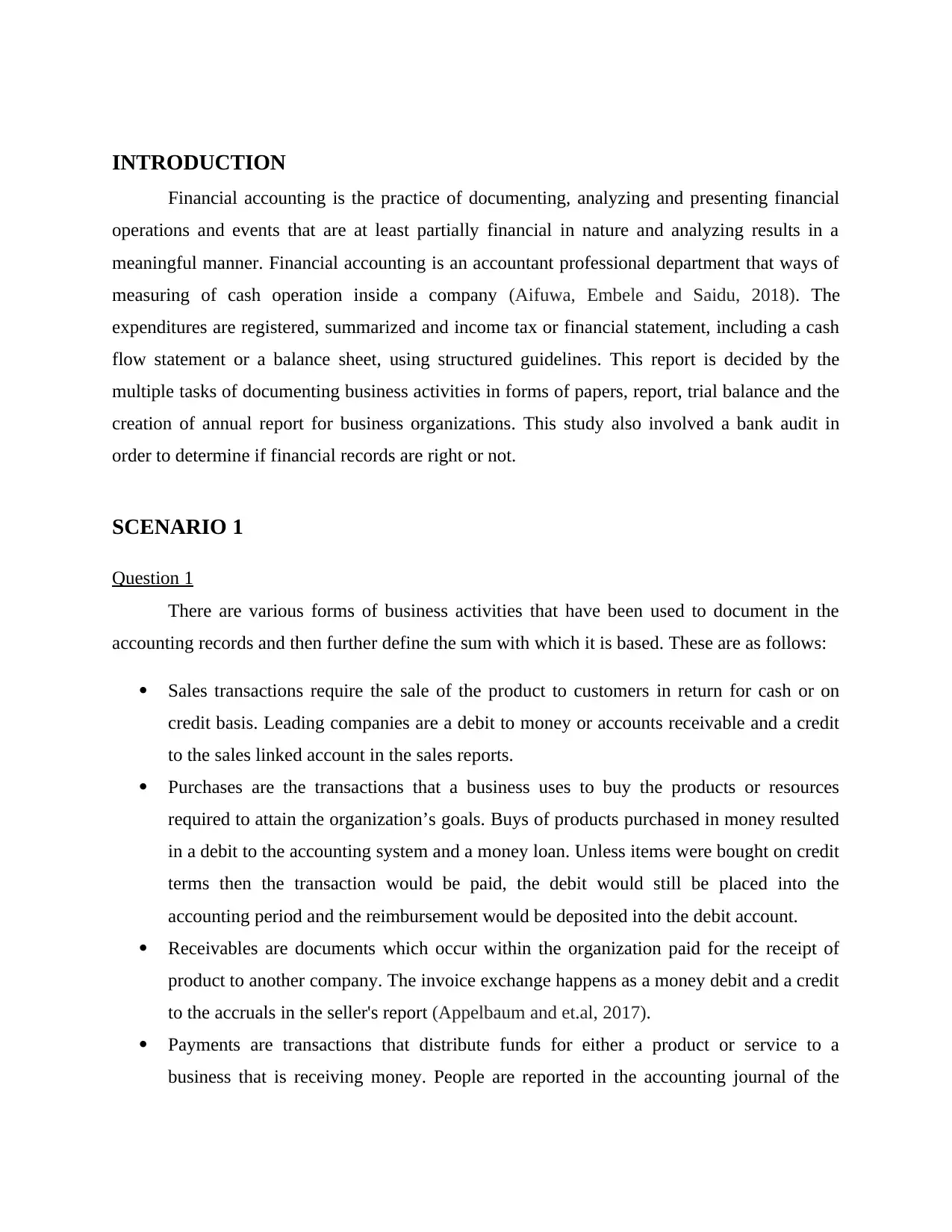
INTRODUCTION
Financial accounting is the practice of documenting, analyzing and presenting financial
operations and events that are at least partially financial in nature and analyzing results in a
meaningful manner. Financial accounting is an accountant professional department that ways of
measuring of cash operation inside a company (Aifuwa, Embele and Saidu, 2018). The
expenditures are registered, summarized and income tax or financial statement, including a cash
flow statement or a balance sheet, using structured guidelines. This report is decided by the
multiple tasks of documenting business activities in forms of papers, report, trial balance and the
creation of annual report for business organizations. This study also involved a bank audit in
order to determine if financial records are right or not.
SCENARIO 1
Question 1
There are various forms of business activities that have been used to document in the
accounting records and then further define the sum with which it is based. These are as follows:
Sales transactions require the sale of the product to customers in return for cash or on
credit basis. Leading companies are a debit to money or accounts receivable and a credit
to the sales linked account in the sales reports.
Purchases are the transactions that a business uses to buy the products or resources
required to attain the organization’s goals. Buys of products purchased in money resulted
in a debit to the accounting system and a money loan. Unless items were bought on credit
terms then the transaction would be paid, the debit would still be placed into the
accounting period and the reimbursement would be deposited into the debit account.
Receivables are documents which occur within the organization paid for the receipt of
product to another company. The invoice exchange happens as a money debit and a credit
to the accruals in the seller's report (Appelbaum and et.al, 2017).
Payments are transactions that distribute funds for either a product or service to a
business that is receiving money. People are reported in the accounting journal of the
Financial accounting is the practice of documenting, analyzing and presenting financial
operations and events that are at least partially financial in nature and analyzing results in a
meaningful manner. Financial accounting is an accountant professional department that ways of
measuring of cash operation inside a company (Aifuwa, Embele and Saidu, 2018). The
expenditures are registered, summarized and income tax or financial statement, including a cash
flow statement or a balance sheet, using structured guidelines. This report is decided by the
multiple tasks of documenting business activities in forms of papers, report, trial balance and the
creation of annual report for business organizations. This study also involved a bank audit in
order to determine if financial records are right or not.
SCENARIO 1
Question 1
There are various forms of business activities that have been used to document in the
accounting records and then further define the sum with which it is based. These are as follows:
Sales transactions require the sale of the product to customers in return for cash or on
credit basis. Leading companies are a debit to money or accounts receivable and a credit
to the sales linked account in the sales reports.
Purchases are the transactions that a business uses to buy the products or resources
required to attain the organization’s goals. Buys of products purchased in money resulted
in a debit to the accounting system and a money loan. Unless items were bought on credit
terms then the transaction would be paid, the debit would still be placed into the
accounting period and the reimbursement would be deposited into the debit account.
Receivables are documents which occur within the organization paid for the receipt of
product to another company. The invoice exchange happens as a money debit and a credit
to the accruals in the seller's report (Appelbaum and et.al, 2017).
Payments are transactions that distribute funds for either a product or service to a
business that is receiving money. People are reported in the accounting journal of the
Secure Best Marks with AI Grader
Need help grading? Try our AI Grader for instant feedback on your assignments.
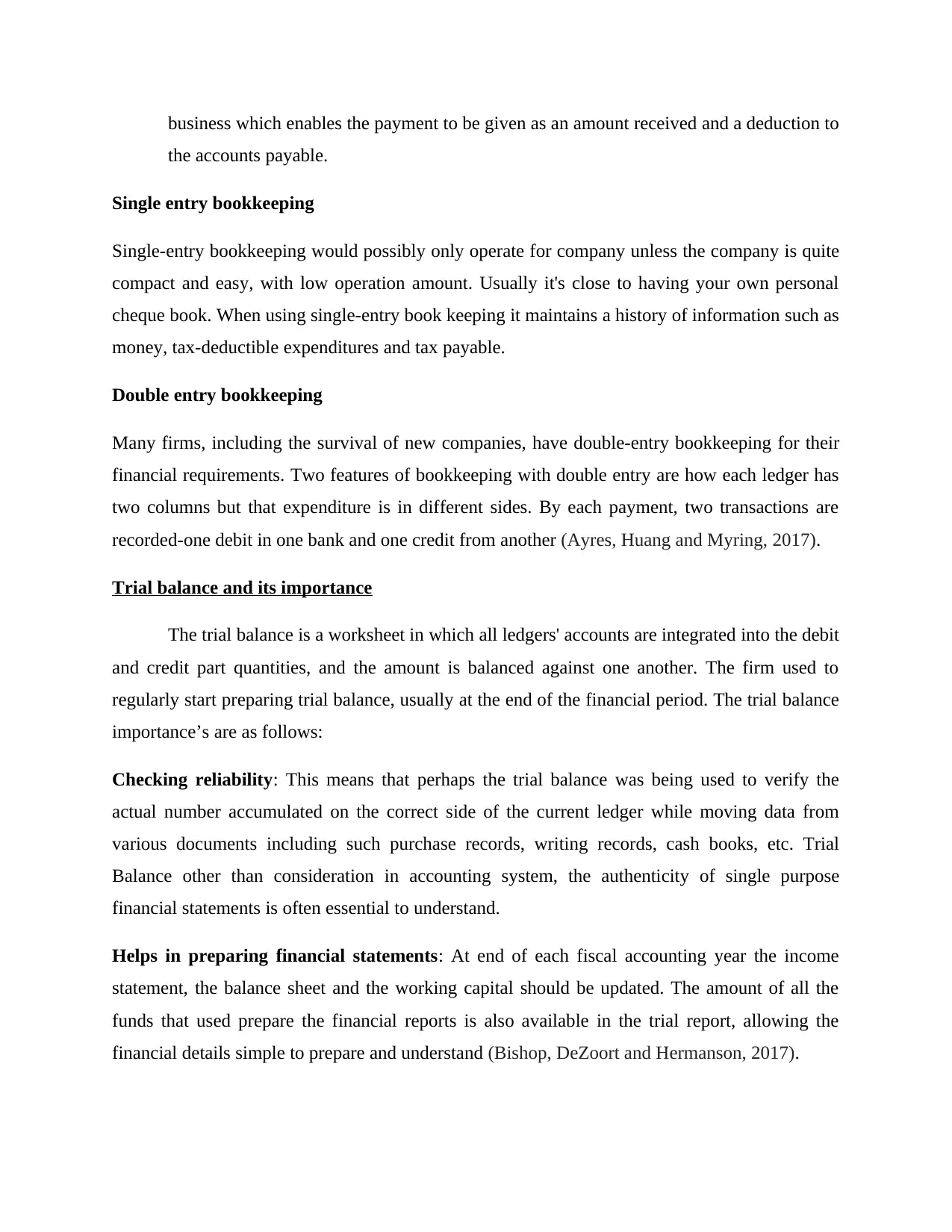
business which enables the payment to be given as an amount received and a deduction to
the accounts payable.
Single entry bookkeeping
Single-entry bookkeeping would possibly only operate for company unless the company is quite
compact and easy, with low operation amount. Usually it's close to having your own personal
cheque book. When using single-entry book keeping it maintains a history of information such as
money, tax-deductible expenditures and tax payable.
Double entry bookkeeping
Many firms, including the survival of new companies, have double-entry bookkeeping for their
financial requirements. Two features of bookkeeping with double entry are how each ledger has
two columns but that expenditure is in different sides. By each payment, two transactions are
recorded-one debit in one bank and one credit from another (Ayres, Huang and Myring, 2017).
Trial balance and its importance
The trial balance is a worksheet in which all ledgers' accounts are integrated into the debit
and credit part quantities, and the amount is balanced against one another. The firm used to
regularly start preparing trial balance, usually at the end of the financial period. The trial balance
importance’s are as follows:
Checking reliability: This means that perhaps the trial balance was being used to verify the
actual number accumulated on the correct side of the current ledger while moving data from
various documents including such purchase records, writing records, cash books, etc. Trial
Balance other than consideration in accounting system, the authenticity of single purpose
financial statements is often essential to understand.
Helps in preparing financial statements: At end of each fiscal accounting year the income
statement, the balance sheet and the working capital should be updated. The amount of all the
funds that used prepare the financial reports is also available in the trial report, allowing the
financial details simple to prepare and understand (Bishop, DeZoort and Hermanson, 2017).
the accounts payable.
Single entry bookkeeping
Single-entry bookkeeping would possibly only operate for company unless the company is quite
compact and easy, with low operation amount. Usually it's close to having your own personal
cheque book. When using single-entry book keeping it maintains a history of information such as
money, tax-deductible expenditures and tax payable.
Double entry bookkeeping
Many firms, including the survival of new companies, have double-entry bookkeeping for their
financial requirements. Two features of bookkeeping with double entry are how each ledger has
two columns but that expenditure is in different sides. By each payment, two transactions are
recorded-one debit in one bank and one credit from another (Ayres, Huang and Myring, 2017).
Trial balance and its importance
The trial balance is a worksheet in which all ledgers' accounts are integrated into the debit
and credit part quantities, and the amount is balanced against one another. The firm used to
regularly start preparing trial balance, usually at the end of the financial period. The trial balance
importance’s are as follows:
Checking reliability: This means that perhaps the trial balance was being used to verify the
actual number accumulated on the correct side of the current ledger while moving data from
various documents including such purchase records, writing records, cash books, etc. Trial
Balance other than consideration in accounting system, the authenticity of single purpose
financial statements is often essential to understand.
Helps in preparing financial statements: At end of each fiscal accounting year the income
statement, the balance sheet and the working capital should be updated. The amount of all the
funds that used prepare the financial reports is also available in the trial report, allowing the
financial details simple to prepare and understand (Bishop, DeZoort and Hermanson, 2017).
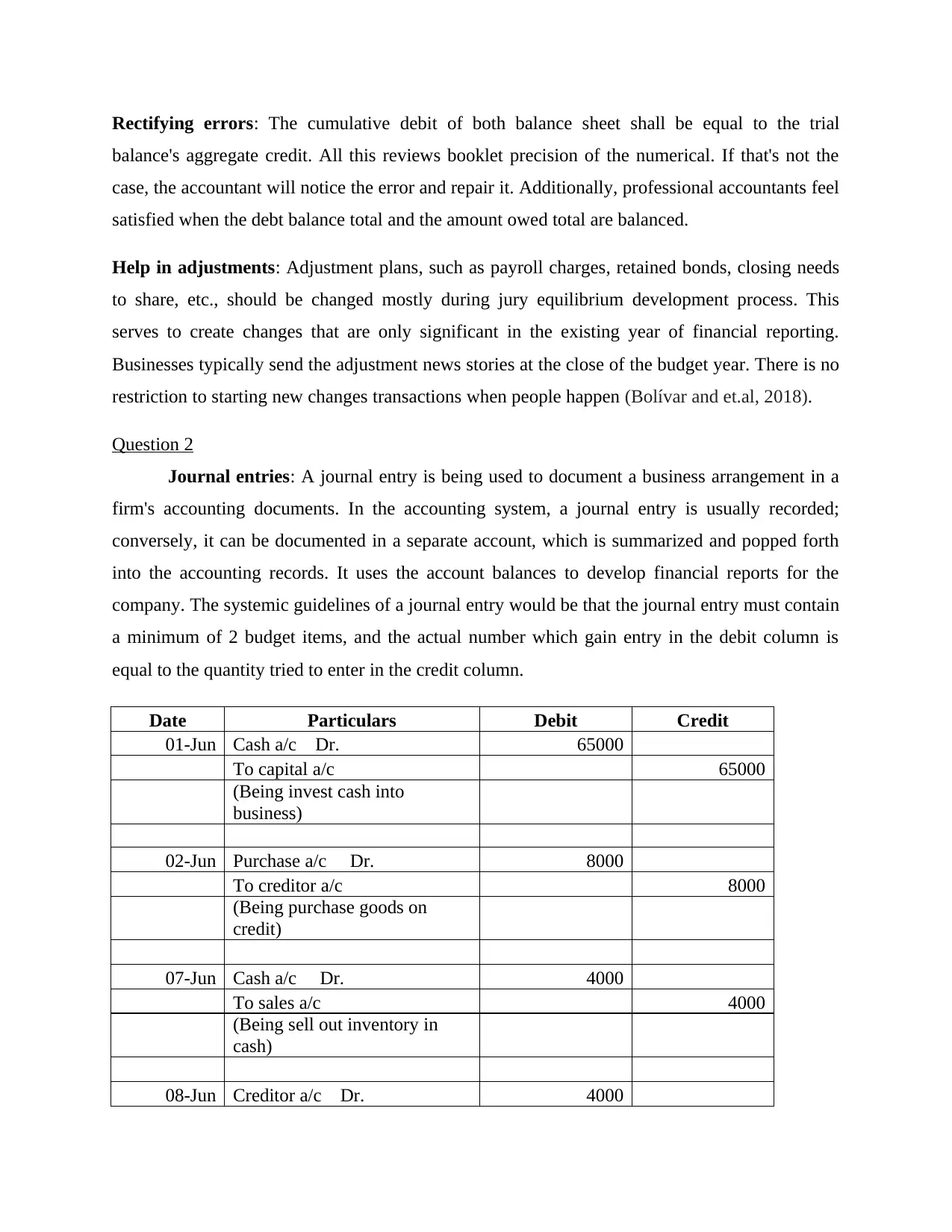
Rectifying errors: The cumulative debit of both balance sheet shall be equal to the trial
balance's aggregate credit. All this reviews booklet precision of the numerical. If that's not the
case, the accountant will notice the error and repair it. Additionally, professional accountants feel
satisfied when the debt balance total and the amount owed total are balanced.
Help in adjustments: Adjustment plans, such as payroll charges, retained bonds, closing needs
to share, etc., should be changed mostly during jury equilibrium development process. This
serves to create changes that are only significant in the existing year of financial reporting.
Businesses typically send the adjustment news stories at the close of the budget year. There is no
restriction to starting new changes transactions when people happen (Bolívar and et.al, 2018).
Question 2
Journal entries: A journal entry is being used to document a business arrangement in a
firm's accounting documents. In the accounting system, a journal entry is usually recorded;
conversely, it can be documented in a separate account, which is summarized and popped forth
into the accounting records. It uses the account balances to develop financial reports for the
company. The systemic guidelines of a journal entry would be that the journal entry must contain
a minimum of 2 budget items, and the actual number which gain entry in the debit column is
equal to the quantity tried to enter in the credit column.
Date Particulars Debit Credit
01-Jun Cash a/c Dr. 65000
To capital a/c 65000
(Being invest cash into
business)
02-Jun Purchase a/c Dr. 8000
To creditor a/c 8000
(Being purchase goods on
credit)
07-Jun Cash a/c Dr. 4000
To sales a/c 4000
(Being sell out inventory in
cash)
08-Jun Creditor a/c Dr. 4000
balance's aggregate credit. All this reviews booklet precision of the numerical. If that's not the
case, the accountant will notice the error and repair it. Additionally, professional accountants feel
satisfied when the debt balance total and the amount owed total are balanced.
Help in adjustments: Adjustment plans, such as payroll charges, retained bonds, closing needs
to share, etc., should be changed mostly during jury equilibrium development process. This
serves to create changes that are only significant in the existing year of financial reporting.
Businesses typically send the adjustment news stories at the close of the budget year. There is no
restriction to starting new changes transactions when people happen (Bolívar and et.al, 2018).
Question 2
Journal entries: A journal entry is being used to document a business arrangement in a
firm's accounting documents. In the accounting system, a journal entry is usually recorded;
conversely, it can be documented in a separate account, which is summarized and popped forth
into the accounting records. It uses the account balances to develop financial reports for the
company. The systemic guidelines of a journal entry would be that the journal entry must contain
a minimum of 2 budget items, and the actual number which gain entry in the debit column is
equal to the quantity tried to enter in the credit column.
Date Particulars Debit Credit
01-Jun Cash a/c Dr. 65000
To capital a/c 65000
(Being invest cash into
business)
02-Jun Purchase a/c Dr. 8000
To creditor a/c 8000
(Being purchase goods on
credit)
07-Jun Cash a/c Dr. 4000
To sales a/c 4000
(Being sell out inventory in
cash)
08-Jun Creditor a/c Dr. 4000

To Bank a/c 4000
(Being issue cheque for
purchase credit goods)
14-Jun Insurance a/c Dr. 75
To Bank a/c 75
(Being pay insurance amount
by cheque)
15-Jun Debtor a/c Dr. 12000
To Sales a/c 12000
(Being sell out inventory on
credit)
16-Jun Purchase a/c Dr. 10000
To Creditor a/c 10000
(Being purchase goods on
credit)
18-Jun Computer equipment a/c Dr. 3000
To Cash a/c 3000
(Being purchase computer
equipment)
20-Jun Rent a/c Dr. 150
To bank a/c 150
(Being paid rent by cheque)
21-Jun Cash a/c Dr. 10000
To sales a/c 10000
(Being sale inventory in cash)
25-Jun Cash a/c Dr. 100
To bank a/c 100
(Being withdraw amount from
bank)
30-Jun Stationary a/c Dr. 30
To cash a/c 30
(Being Purchase stationery into
cash)
(Being issue cheque for
purchase credit goods)
14-Jun Insurance a/c Dr. 75
To Bank a/c 75
(Being pay insurance amount
by cheque)
15-Jun Debtor a/c Dr. 12000
To Sales a/c 12000
(Being sell out inventory on
credit)
16-Jun Purchase a/c Dr. 10000
To Creditor a/c 10000
(Being purchase goods on
credit)
18-Jun Computer equipment a/c Dr. 3000
To Cash a/c 3000
(Being purchase computer
equipment)
20-Jun Rent a/c Dr. 150
To bank a/c 150
(Being paid rent by cheque)
21-Jun Cash a/c Dr. 10000
To sales a/c 10000
(Being sale inventory in cash)
25-Jun Cash a/c Dr. 100
To bank a/c 100
(Being withdraw amount from
bank)
30-Jun Stationary a/c Dr. 30
To cash a/c 30
(Being Purchase stationery into
cash)
Paraphrase This Document
Need a fresh take? Get an instant paraphrase of this document with our AI Paraphraser
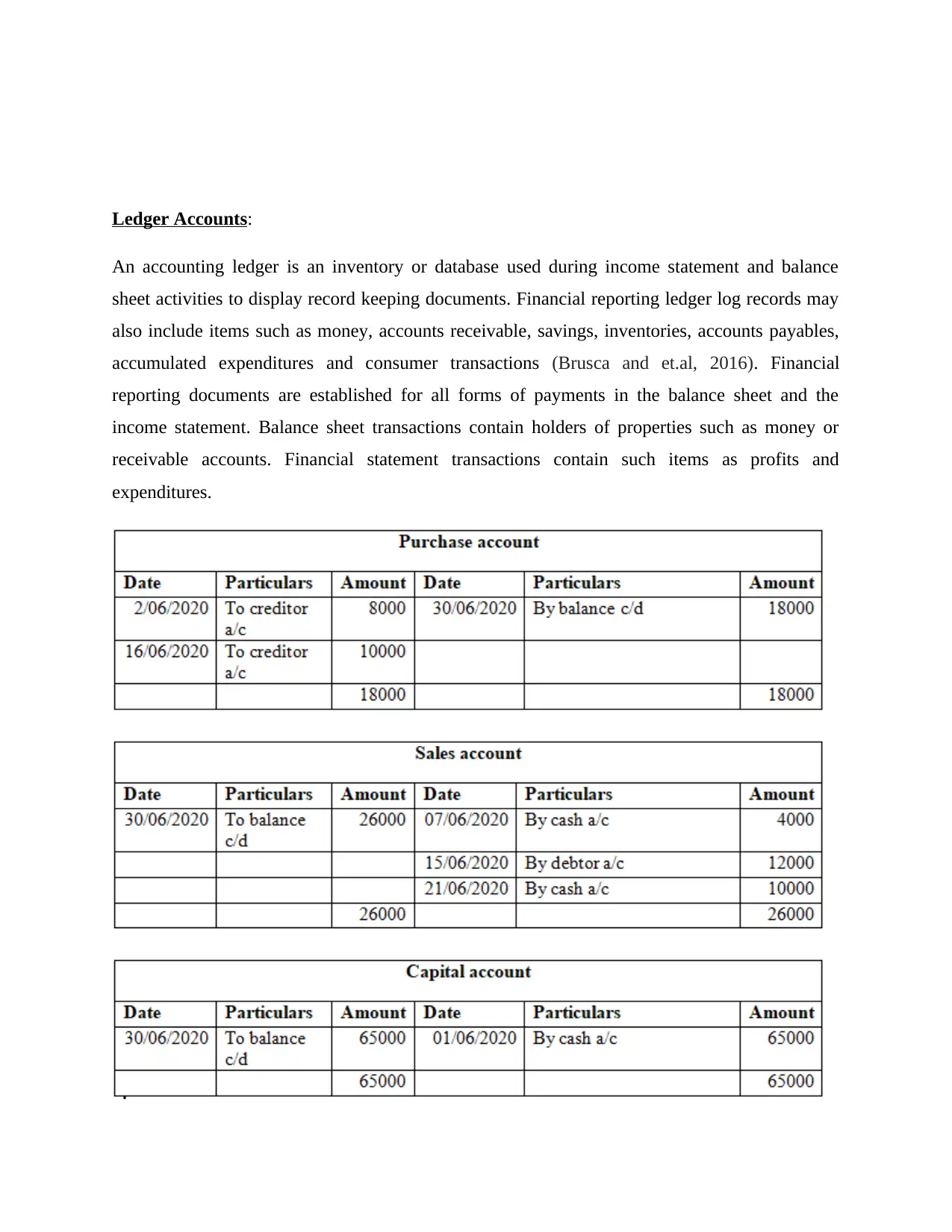
Ledger Accounts:
An accounting ledger is an inventory or database used during income statement and balance
sheet activities to display record keeping documents. Financial reporting ledger log records may
also include items such as money, accounts receivable, savings, inventories, accounts payables,
accumulated expenditures and consumer transactions (Brusca and et.al, 2016). Financial
reporting documents are established for all forms of payments in the balance sheet and the
income statement. Balance sheet transactions contain holders of properties such as money or
receivable accounts. Financial statement transactions contain such items as profits and
expenditures.
An accounting ledger is an inventory or database used during income statement and balance
sheet activities to display record keeping documents. Financial reporting ledger log records may
also include items such as money, accounts receivable, savings, inventories, accounts payables,
accumulated expenditures and consumer transactions (Brusca and et.al, 2016). Financial
reporting documents are established for all forms of payments in the balance sheet and the
income statement. Balance sheet transactions contain holders of properties such as money or
receivable accounts. Financial statement transactions contain such items as profits and
expenditures.

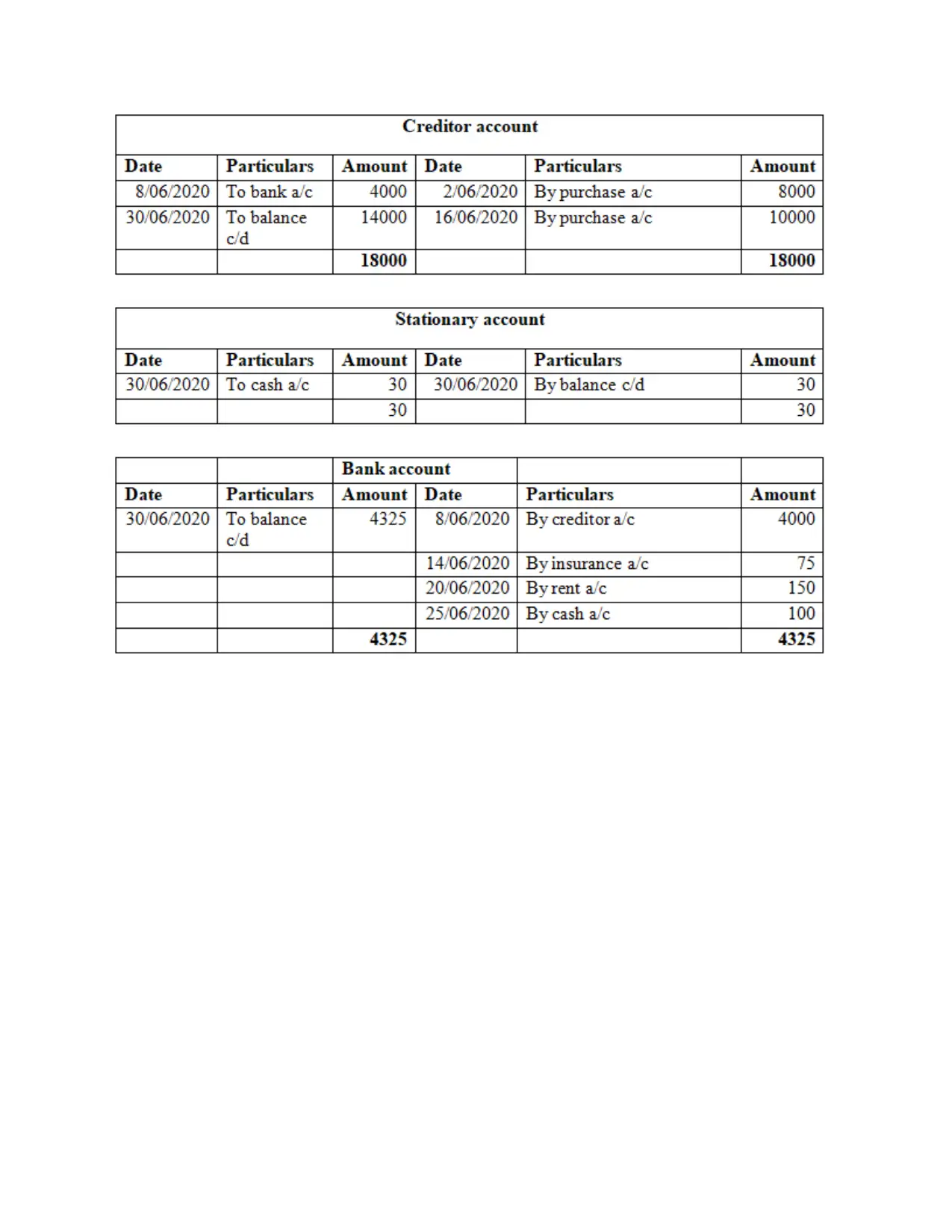
Secure Best Marks with AI Grader
Need help grading? Try our AI Grader for instant feedback on your assignments.
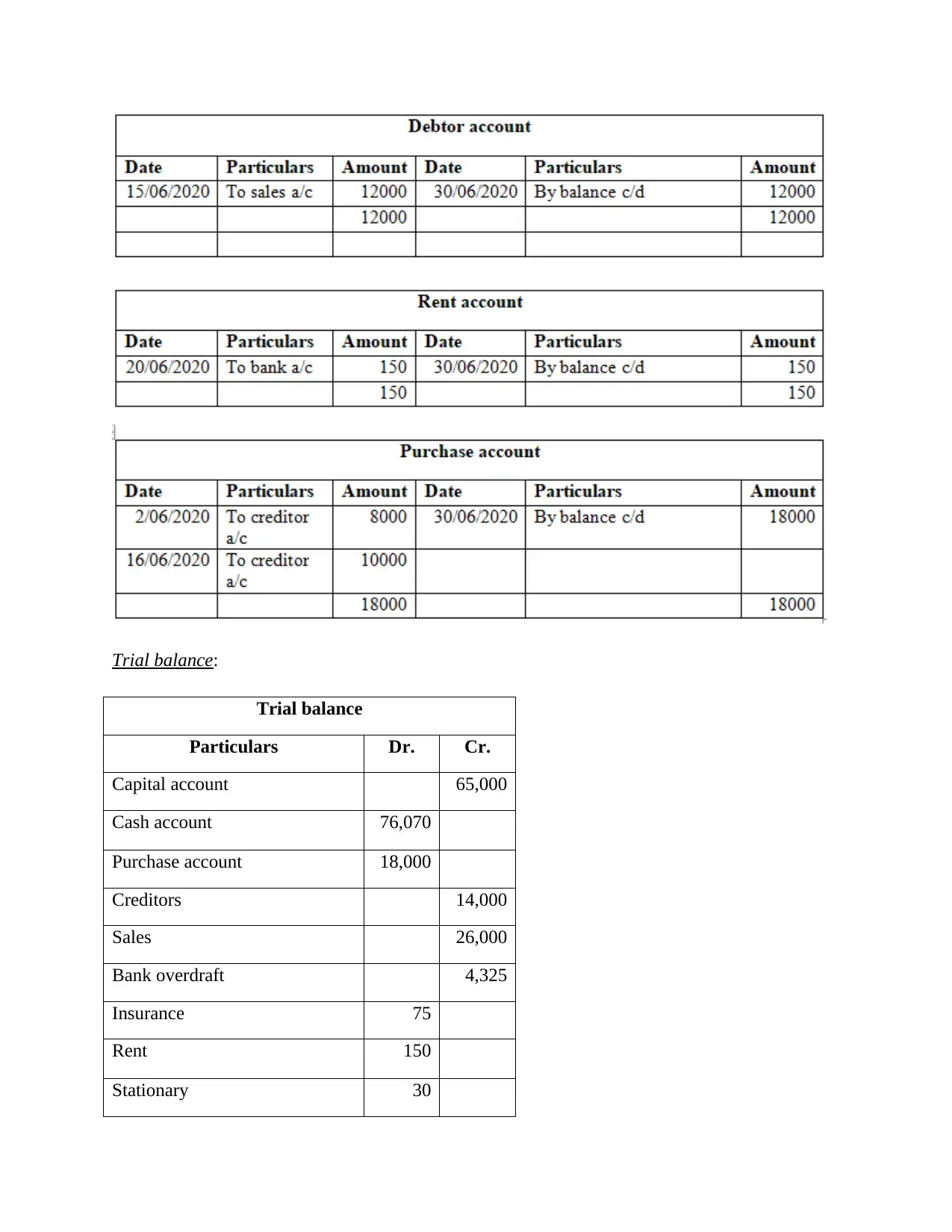
Trial balance:
Trial balance
Particulars Dr. Cr.
Capital account 65,000
Cash account 76,070
Purchase account 18,000
Creditors 14,000
Sales 26,000
Bank overdraft 4,325
Insurance 75
Rent 150
Stationary 30
Trial balance
Particulars Dr. Cr.
Capital account 65,000
Cash account 76,070
Purchase account 18,000
Creditors 14,000
Sales 26,000
Bank overdraft 4,325
Insurance 75
Rent 150
Stationary 30

Debtor 12,000
Computer equipment 3,000
109,32
5
109,32
5
Question 3
Financial reporting is a process of primary interface staff with information in order to
make effective decisions and the income report is the result of the financial reports. That is the
main distinction between financial reporting and accounts. Financial statements have been
prepared over a specific accounting period, usually for one year. This accounting period is linked
to as a 'financial year' and is different from a schedule period, because the financial statement
may vary depending on the situation of the organisation or business (Gotti, 2016). Financial
Statements are meant to even provide data on business situation, working capital and operating
performance. This process helped those statements' viewers make planning and decision. These
reports seek to identify commodity use, cash flow, corporate reputation and the company's
financial wellbeing. This allows traders and individuals make better decisions as to how the
company should be managed.
The concepts "financial report" and "financial statement" are considered synonymous, not
even in the same way. "Financial report" is a paragliding concept that underlies so many kinds of
reporting. This one study which comes under the umbrella of the financial report is the income
reports. In many other sentences, all annual reports are accounting standards, but the income
accounts may not all be.
Requirement of financial reports and its users:
According to the GAAPs, organizations are paying for trying to report on their retained
earnings, profit-making operational efficiency economic policies. The preceding 3 major
financial statements must be prepared underneath the GAAP, including such statement of
comprehensive income, balance sheet and statement of working capital. Even without heavy
price of updating their GL or ERP, financial reporting system can be combined with the current
general ledger, offering solid and current incorporated analyses. When the firm has built the right
Computer equipment 3,000
109,32
5
109,32
5
Question 3
Financial reporting is a process of primary interface staff with information in order to
make effective decisions and the income report is the result of the financial reports. That is the
main distinction between financial reporting and accounts. Financial statements have been
prepared over a specific accounting period, usually for one year. This accounting period is linked
to as a 'financial year' and is different from a schedule period, because the financial statement
may vary depending on the situation of the organisation or business (Gotti, 2016). Financial
Statements are meant to even provide data on business situation, working capital and operating
performance. This process helped those statements' viewers make planning and decision. These
reports seek to identify commodity use, cash flow, corporate reputation and the company's
financial wellbeing. This allows traders and individuals make better decisions as to how the
company should be managed.
The concepts "financial report" and "financial statement" are considered synonymous, not
even in the same way. "Financial report" is a paragliding concept that underlies so many kinds of
reporting. This one study which comes under the umbrella of the financial report is the income
reports. In many other sentences, all annual reports are accounting standards, but the income
accounts may not all be.
Requirement of financial reports and its users:
According to the GAAPs, organizations are paying for trying to report on their retained
earnings, profit-making operational efficiency economic policies. The preceding 3 major
financial statements must be prepared underneath the GAAP, including such statement of
comprehensive income, balance sheet and statement of working capital. Even without heavy
price of updating their GL or ERP, financial reporting system can be combined with the current
general ledger, offering solid and current incorporated analyses. When the firm has built the right
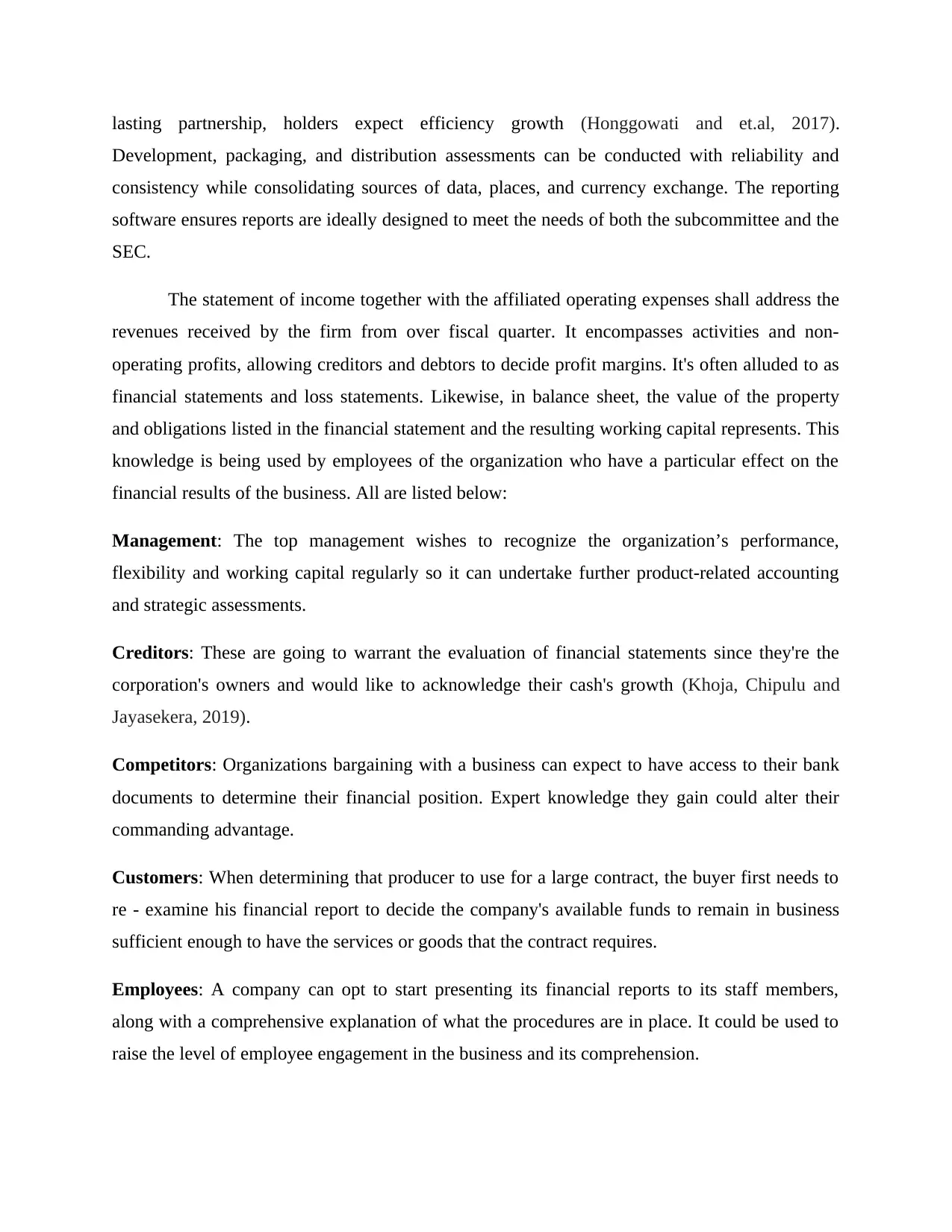
lasting partnership, holders expect efficiency growth (Honggowati and et.al, 2017).
Development, packaging, and distribution assessments can be conducted with reliability and
consistency while consolidating sources of data, places, and currency exchange. The reporting
software ensures reports are ideally designed to meet the needs of both the subcommittee and the
SEC.
The statement of income together with the affiliated operating expenses shall address the
revenues received by the firm from over fiscal quarter. It encompasses activities and non-
operating profits, allowing creditors and debtors to decide profit margins. It's often alluded to as
financial statements and loss statements. Likewise, in balance sheet, the value of the property
and obligations listed in the financial statement and the resulting working capital represents. This
knowledge is being used by employees of the organization who have a particular effect on the
financial results of the business. All are listed below:
Management: The top management wishes to recognize the organization’s performance,
flexibility and working capital regularly so it can undertake further product-related accounting
and strategic assessments.
Creditors: These are going to warrant the evaluation of financial statements since they're the
corporation's owners and would like to acknowledge their cash's growth (Khoja, Chipulu and
Jayasekera, 2019).
Competitors: Organizations bargaining with a business can expect to have access to their bank
documents to determine their financial position. Expert knowledge they gain could alter their
commanding advantage.
Customers: When determining that producer to use for a large contract, the buyer first needs to
re - examine his financial report to decide the company's available funds to remain in business
sufficient enough to have the services or goods that the contract requires.
Employees: A company can opt to start presenting its financial reports to its staff members,
along with a comprehensive explanation of what the procedures are in place. It could be used to
raise the level of employee engagement in the business and its comprehension.
Development, packaging, and distribution assessments can be conducted with reliability and
consistency while consolidating sources of data, places, and currency exchange. The reporting
software ensures reports are ideally designed to meet the needs of both the subcommittee and the
SEC.
The statement of income together with the affiliated operating expenses shall address the
revenues received by the firm from over fiscal quarter. It encompasses activities and non-
operating profits, allowing creditors and debtors to decide profit margins. It's often alluded to as
financial statements and loss statements. Likewise, in balance sheet, the value of the property
and obligations listed in the financial statement and the resulting working capital represents. This
knowledge is being used by employees of the organization who have a particular effect on the
financial results of the business. All are listed below:
Management: The top management wishes to recognize the organization’s performance,
flexibility and working capital regularly so it can undertake further product-related accounting
and strategic assessments.
Creditors: These are going to warrant the evaluation of financial statements since they're the
corporation's owners and would like to acknowledge their cash's growth (Khoja, Chipulu and
Jayasekera, 2019).
Competitors: Organizations bargaining with a business can expect to have access to their bank
documents to determine their financial position. Expert knowledge they gain could alter their
commanding advantage.
Customers: When determining that producer to use for a large contract, the buyer first needs to
re - examine his financial report to decide the company's available funds to remain in business
sufficient enough to have the services or goods that the contract requires.
Employees: A company can opt to start presenting its financial reports to its staff members,
along with a comprehensive explanation of what the procedures are in place. It could be used to
raise the level of employee engagement in the business and its comprehension.
Paraphrase This Document
Need a fresh take? Get an instant paraphrase of this document with our AI Paraphraser
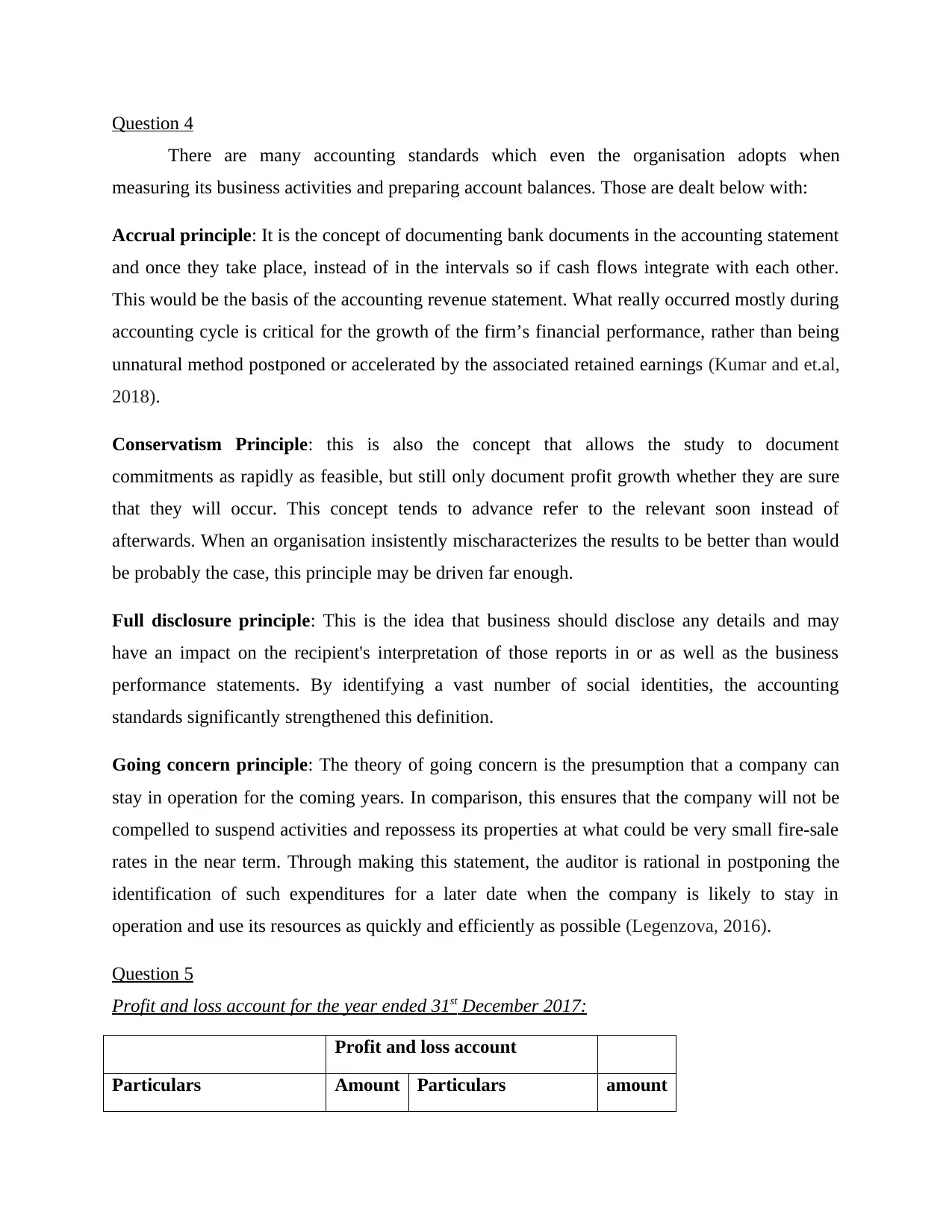
Question 4
There are many accounting standards which even the organisation adopts when
measuring its business activities and preparing account balances. Those are dealt below with:
Accrual principle: It is the concept of documenting bank documents in the accounting statement
and once they take place, instead of in the intervals so if cash flows integrate with each other.
This would be the basis of the accounting revenue statement. What really occurred mostly during
accounting cycle is critical for the growth of the firm’s financial performance, rather than being
unnatural method postponed or accelerated by the associated retained earnings (Kumar and et.al,
2018).
Conservatism Principle: this is also the concept that allows the study to document
commitments as rapidly as feasible, but still only document profit growth whether they are sure
that they will occur. This concept tends to advance refer to the relevant soon instead of
afterwards. When an organisation insistently mischaracterizes the results to be better than would
be probably the case, this principle may be driven far enough.
Full disclosure principle: This is the idea that business should disclose any details and may
have an impact on the recipient's interpretation of those reports in or as well as the business
performance statements. By identifying a vast number of social identities, the accounting
standards significantly strengthened this definition.
Going concern principle: The theory of going concern is the presumption that a company can
stay in operation for the coming years. In comparison, this ensures that the company will not be
compelled to suspend activities and repossess its properties at what could be very small fire-sale
rates in the near term. Through making this statement, the auditor is rational in postponing the
identification of such expenditures for a later date when the company is likely to stay in
operation and use its resources as quickly and efficiently as possible (Legenzova, 2016).
Question 5
Profit and loss account for the year ended 31st December 2017:
Profit and loss account
Particulars Amount Particulars amount
There are many accounting standards which even the organisation adopts when
measuring its business activities and preparing account balances. Those are dealt below with:
Accrual principle: It is the concept of documenting bank documents in the accounting statement
and once they take place, instead of in the intervals so if cash flows integrate with each other.
This would be the basis of the accounting revenue statement. What really occurred mostly during
accounting cycle is critical for the growth of the firm’s financial performance, rather than being
unnatural method postponed or accelerated by the associated retained earnings (Kumar and et.al,
2018).
Conservatism Principle: this is also the concept that allows the study to document
commitments as rapidly as feasible, but still only document profit growth whether they are sure
that they will occur. This concept tends to advance refer to the relevant soon instead of
afterwards. When an organisation insistently mischaracterizes the results to be better than would
be probably the case, this principle may be driven far enough.
Full disclosure principle: This is the idea that business should disclose any details and may
have an impact on the recipient's interpretation of those reports in or as well as the business
performance statements. By identifying a vast number of social identities, the accounting
standards significantly strengthened this definition.
Going concern principle: The theory of going concern is the presumption that a company can
stay in operation for the coming years. In comparison, this ensures that the company will not be
compelled to suspend activities and repossess its properties at what could be very small fire-sale
rates in the near term. Through making this statement, the auditor is rational in postponing the
identification of such expenditures for a later date when the company is likely to stay in
operation and use its resources as quickly and efficiently as possible (Legenzova, 2016).
Question 5
Profit and loss account for the year ended 31st December 2017:
Profit and loss account
Particulars Amount Particulars amount
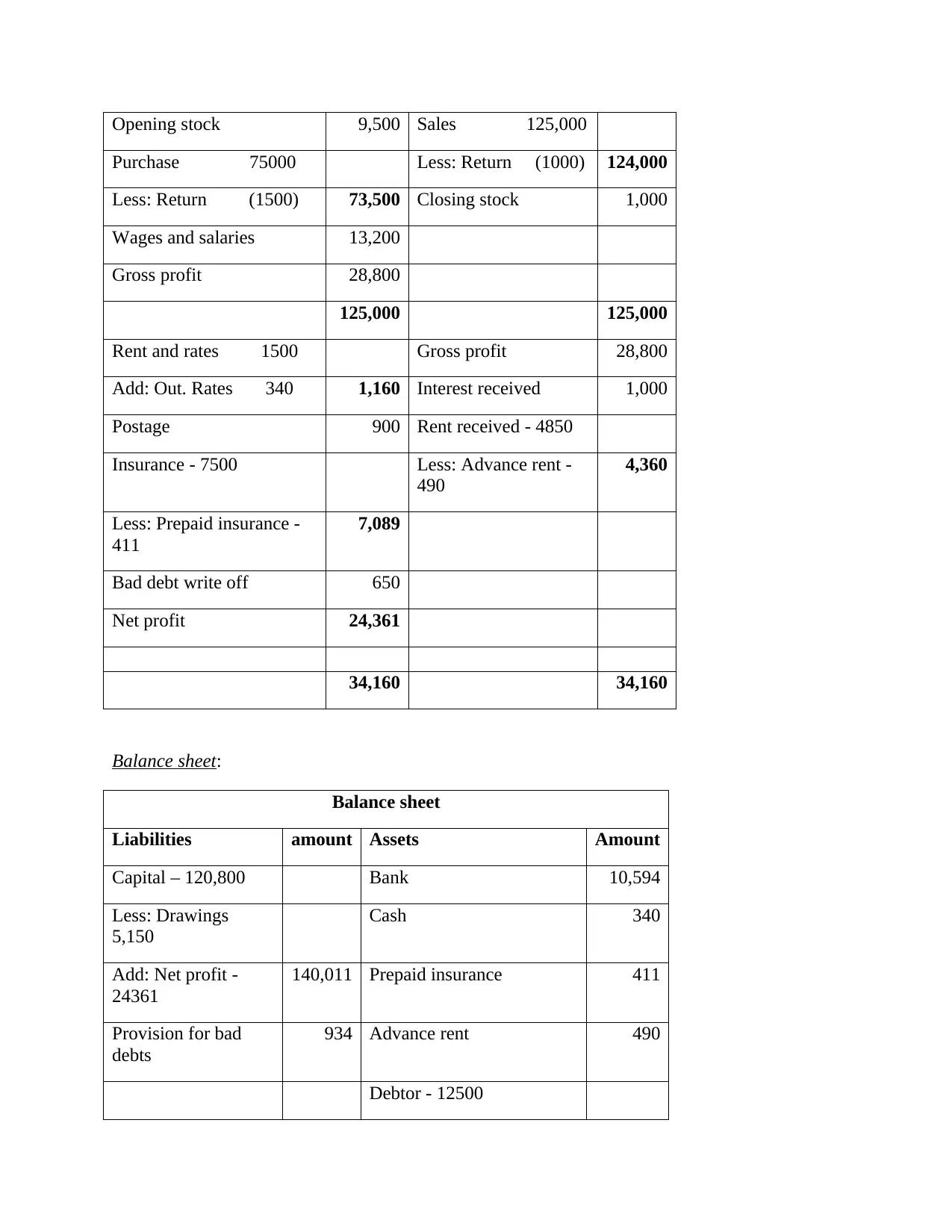
Opening stock 9,500 Sales 125,000
Purchase 75000 Less: Return (1000) 124,000
Less: Return (1500) 73,500 Closing stock 1,000
Wages and salaries 13,200
Gross profit 28,800
125,000 125,000
Rent and rates 1500 Gross profit 28,800
Add: Out. Rates 340 1,160 Interest received 1,000
Postage 900 Rent received - 4850
Insurance - 7500 Less: Advance rent -
490
4,360
Less: Prepaid insurance -
411
7,089
Bad debt write off 650
Net profit 24,361
34,160 34,160
Balance sheet:
Balance sheet
Liabilities amount Assets Amount
Capital – 120,800 Bank 10,594
Less: Drawings
5,150
Cash 340
Add: Net profit -
24361
140,011 Prepaid insurance 411
Provision for bad
debts
934 Advance rent 490
Debtor - 12500
Purchase 75000 Less: Return (1000) 124,000
Less: Return (1500) 73,500 Closing stock 1,000
Wages and salaries 13,200
Gross profit 28,800
125,000 125,000
Rent and rates 1500 Gross profit 28,800
Add: Out. Rates 340 1,160 Interest received 1,000
Postage 900 Rent received - 4850
Insurance - 7500 Less: Advance rent -
490
4,360
Less: Prepaid insurance -
411
7,089
Bad debt write off 650
Net profit 24,361
34,160 34,160
Balance sheet:
Balance sheet
Liabilities amount Assets Amount
Capital – 120,800 Bank 10,594
Less: Drawings
5,150
Cash 340
Add: Net profit -
24361
140,011 Prepaid insurance 411
Provision for bad
debts
934 Advance rent 490
Debtor - 12500

Creditor 3,900 Less: Bad debt write off -
934
11,850
Outstanding rates 340 Motor van at WDV - 19600
Less: Dep - 5000 14,600
Loan 100,000
Closing stock 1,000
145,185 145,185
SCENARIO 2
Question 1
It is a presumption that persons are able to recognize, clarify and accept any differences
in the difference between the bank statement and the balance as per the financial statements. Any
agreement between the issuer and the bank is agreed by all party representatives to enter
separately in their papers. For just a multitude of reasons which show various balances, these
documentation may be dissatisfied. The purpose of providing financial report is to identify and
clarify the reasons of this difference in checking account (Liang and Zhang, 2019).
Why bank reconciliation is required and how to achieve it:
Bank reconciliation procedures are conducted immediately to verify the bank records of
the company individually. The fundamental accounting demonstrates the variation between the
'Cash at Bank' value and the true value on the credit card. Business and bank hold financial
documents of the very same quantity of funds involved in the financial with bank. Some
differences relate to the fact that cash transactions recorded but at the other hand are sometimes
uneducated about record player. Money also obtained commercial transactions that may have
been reported and have not yet been documented in financial records or loan amount paid by the
loan from the corporation's bank account but has not notified by the corporation.
Another reason for allowing bank reconciliation is to accept the amount of capital
efficiently in the employment of the employees. The amount of funds mentioned on the bank
934
11,850
Outstanding rates 340 Motor van at WDV - 19600
Less: Dep - 5000 14,600
Loan 100,000
Closing stock 1,000
145,185 145,185
SCENARIO 2
Question 1
It is a presumption that persons are able to recognize, clarify and accept any differences
in the difference between the bank statement and the balance as per the financial statements. Any
agreement between the issuer and the bank is agreed by all party representatives to enter
separately in their papers. For just a multitude of reasons which show various balances, these
documentation may be dissatisfied. The purpose of providing financial report is to identify and
clarify the reasons of this difference in checking account (Liang and Zhang, 2019).
Why bank reconciliation is required and how to achieve it:
Bank reconciliation procedures are conducted immediately to verify the bank records of
the company individually. The fundamental accounting demonstrates the variation between the
'Cash at Bank' value and the true value on the credit card. Business and bank hold financial
documents of the very same quantity of funds involved in the financial with bank. Some
differences relate to the fact that cash transactions recorded but at the other hand are sometimes
uneducated about record player. Money also obtained commercial transactions that may have
been reported and have not yet been documented in financial records or loan amount paid by the
loan from the corporation's bank account but has not notified by the corporation.
Another reason for allowing bank reconciliation is to accept the amount of capital
efficiently in the employment of the employees. The amount of funds mentioned on the bank
Secure Best Marks with AI Grader
Need help grading? Try our AI Grader for instant feedback on your assignments.
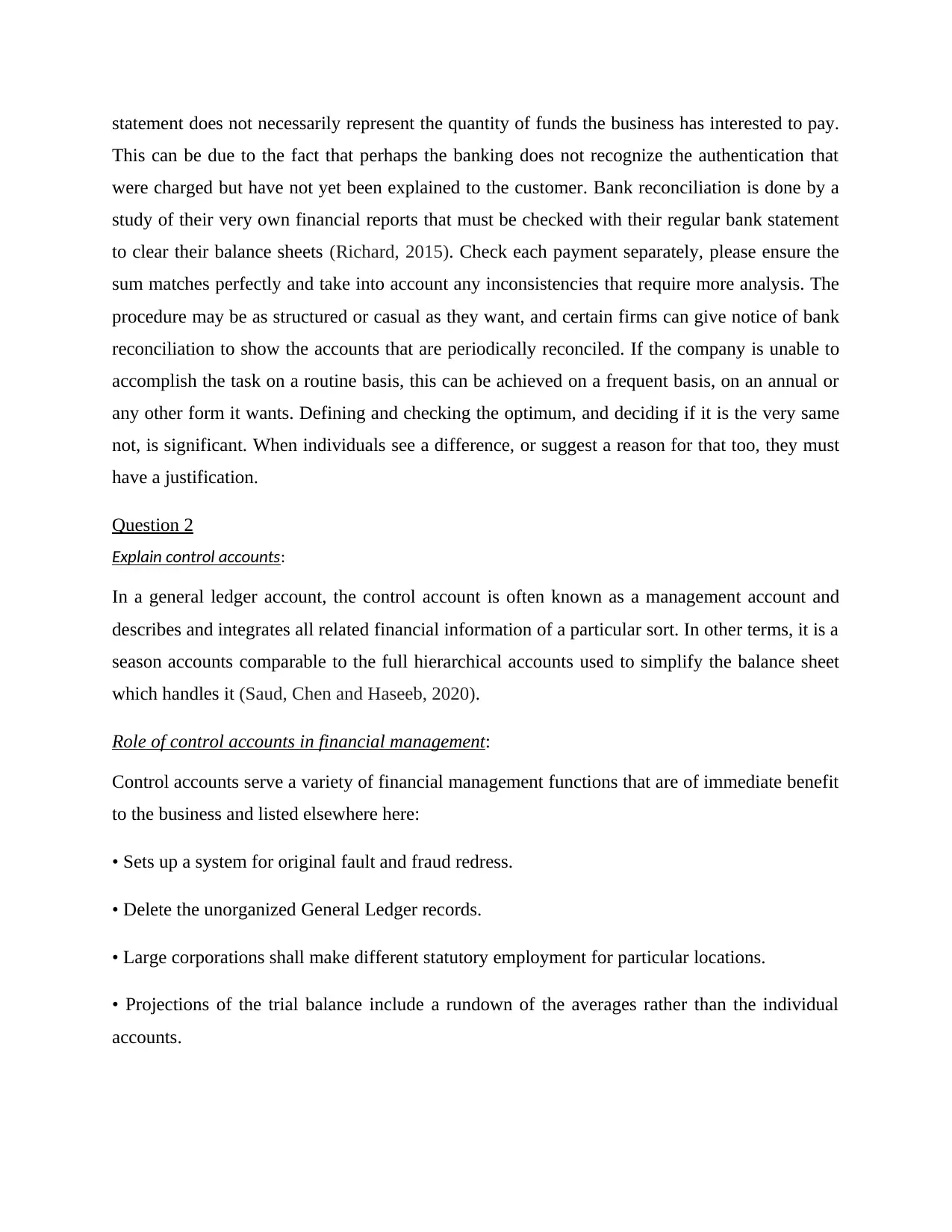
statement does not necessarily represent the quantity of funds the business has interested to pay.
This can be due to the fact that perhaps the banking does not recognize the authentication that
were charged but have not yet been explained to the customer. Bank reconciliation is done by a
study of their very own financial reports that must be checked with their regular bank statement
to clear their balance sheets (Richard, 2015). Check each payment separately, please ensure the
sum matches perfectly and take into account any inconsistencies that require more analysis. The
procedure may be as structured or casual as they want, and certain firms can give notice of bank
reconciliation to show the accounts that are periodically reconciled. If the company is unable to
accomplish the task on a routine basis, this can be achieved on a frequent basis, on an annual or
any other form it wants. Defining and checking the optimum, and deciding if it is the very same
not, is significant. When individuals see a difference, or suggest a reason for that too, they must
have a justification.
Question 2
Explain control accounts:
In a general ledger account, the control account is often known as a management account and
describes and integrates all related financial information of a particular sort. In other terms, it is a
season accounts comparable to the full hierarchical accounts used to simplify the balance sheet
which handles it (Saud, Chen and Haseeb, 2020).
Role of control accounts in financial management:
Control accounts serve a variety of financial management functions that are of immediate benefit
to the business and listed elsewhere here:
• Sets up a system for original fault and fraud redress.
• Delete the unorganized General Ledger records.
• Large corporations shall make different statutory employment for particular locations.
• Projections of the trial balance include a rundown of the averages rather than the individual
accounts.
This can be due to the fact that perhaps the banking does not recognize the authentication that
were charged but have not yet been explained to the customer. Bank reconciliation is done by a
study of their very own financial reports that must be checked with their regular bank statement
to clear their balance sheets (Richard, 2015). Check each payment separately, please ensure the
sum matches perfectly and take into account any inconsistencies that require more analysis. The
procedure may be as structured or casual as they want, and certain firms can give notice of bank
reconciliation to show the accounts that are periodically reconciled. If the company is unable to
accomplish the task on a routine basis, this can be achieved on a frequent basis, on an annual or
any other form it wants. Defining and checking the optimum, and deciding if it is the very same
not, is significant. When individuals see a difference, or suggest a reason for that too, they must
have a justification.
Question 2
Explain control accounts:
In a general ledger account, the control account is often known as a management account and
describes and integrates all related financial information of a particular sort. In other terms, it is a
season accounts comparable to the full hierarchical accounts used to simplify the balance sheet
which handles it (Saud, Chen and Haseeb, 2020).
Role of control accounts in financial management:
Control accounts serve a variety of financial management functions that are of immediate benefit
to the business and listed elsewhere here:
• Sets up a system for original fault and fraud redress.
• Delete the unorganized General Ledger records.
• Large corporations shall make different statutory employment for particular locations.
• Projections of the trial balance include a rundown of the averages rather than the individual
accounts.

• Eliminates the possibility of fraud, particularly although this payment processing documents
and the primary report are handled separately by different personnel.
Question 3
Explain suspense account:
Suspense account is defined as a general ledger account wherein the company keeps
documenting its ambiguous entries and may need additional study to decide each person's
marketing funnel or position. Suspense account is a form in which the investor restaurants their
capital for an amount of time before being used through to public expenditure (Tahat and
Alhadab, 2017).
Reasons of drafting suspense account:
This account may also be formulated wherein the appropriate reimbursement at the time the
transactions were initially approved could not be recorded or quantified. A few instances of this
will be when such a recipient provides a limited bill, even if they're uncertain that bill people
pay. Whenever the payment volatility is resolved with the consumer, the equilibrium attributable
will be relocated from the consideration of expectation to the account linked.
Unless the trial balance of the company continues to be so out of reach, the imbalance will stay
in the expectation fund until the other difference is fixed. The assumption payment will be shown
on the trial balance under the moving "Other counterparty assets." unless the company has
realized and corrected the justification for the disparity, the assumption equilibrium will be
connected; although the trial balance would no matter how much experience be involved.
Question 4
Updated cash book as at 28th February 2017:
Revised cash Book
Particulars Dr. Particular Cr.
Balance b/d 1,760 D.Park 270
Insurance against fire 170 Mr. Akram 105
and the primary report are handled separately by different personnel.
Question 3
Explain suspense account:
Suspense account is defined as a general ledger account wherein the company keeps
documenting its ambiguous entries and may need additional study to decide each person's
marketing funnel or position. Suspense account is a form in which the investor restaurants their
capital for an amount of time before being used through to public expenditure (Tahat and
Alhadab, 2017).
Reasons of drafting suspense account:
This account may also be formulated wherein the appropriate reimbursement at the time the
transactions were initially approved could not be recorded or quantified. A few instances of this
will be when such a recipient provides a limited bill, even if they're uncertain that bill people
pay. Whenever the payment volatility is resolved with the consumer, the equilibrium attributable
will be relocated from the consideration of expectation to the account linked.
Unless the trial balance of the company continues to be so out of reach, the imbalance will stay
in the expectation fund until the other difference is fixed. The assumption payment will be shown
on the trial balance under the moving "Other counterparty assets." unless the company has
realized and corrected the justification for the disparity, the assumption equilibrium will be
connected; although the trial balance would no matter how much experience be involved.
Question 4
Updated cash book as at 28th February 2017:
Revised cash Book
Particulars Dr. Particular Cr.
Balance b/d 1,760 D.Park 270
Insurance against fire 170 Mr. Akram 105

Monthly bill 56 Bank Collection 325
Arif Paid 186
Bank Charges 25 Balance c/f 1497
2,197 2,197
Bank reconciliation statement as on 28th February 2017:
Particular Amount
Balance as per Bank 3,093
Add:
Bank Charges 25
Arif Paid 186
Monthly bill 56
Fire insurance 170
Less:
D.Park 270
Mr. Akram 105
Bank collection 325
Balance as per cash book 2,830
Explain the following terms:
Arif Paid 186
Bank Charges 25 Balance c/f 1497
2,197 2,197
Bank reconciliation statement as on 28th February 2017:
Particular Amount
Balance as per Bank 3,093
Add:
Bank Charges 25
Arif Paid 186
Monthly bill 56
Fire insurance 170
Less:
D.Park 270
Mr. Akram 105
Bank collection 325
Balance as per cash book 2,830
Explain the following terms:
Paraphrase This Document
Need a fresh take? Get an instant paraphrase of this document with our AI Paraphraser
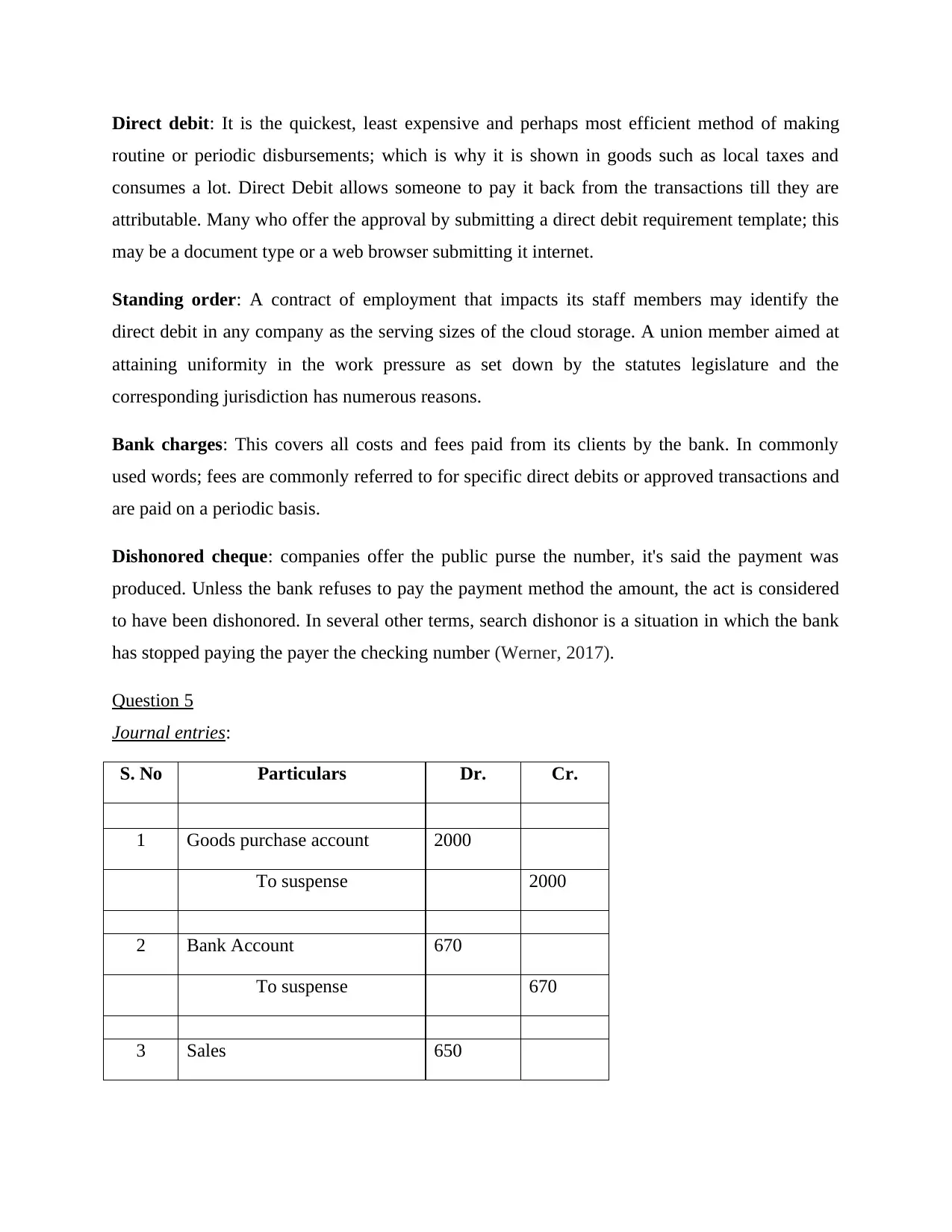
Direct debit: It is the quickest, least expensive and perhaps most efficient method of making
routine or periodic disbursements; which is why it is shown in goods such as local taxes and
consumes a lot. Direct Debit allows someone to pay it back from the transactions till they are
attributable. Many who offer the approval by submitting a direct debit requirement template; this
may be a document type or a web browser submitting it internet.
Standing order: A contract of employment that impacts its staff members may identify the
direct debit in any company as the serving sizes of the cloud storage. A union member aimed at
attaining uniformity in the work pressure as set down by the statutes legislature and the
corresponding jurisdiction has numerous reasons.
Bank charges: This covers all costs and fees paid from its clients by the bank. In commonly
used words; fees are commonly referred to for specific direct debits or approved transactions and
are paid on a periodic basis.
Dishonored cheque: companies offer the public purse the number, it's said the payment was
produced. Unless the bank refuses to pay the payment method the amount, the act is considered
to have been dishonored. In several other terms, search dishonor is a situation in which the bank
has stopped paying the payer the checking number (Werner, 2017).
Question 5
Journal entries:
S. No Particulars Dr. Cr.
1 Goods purchase account 2000
To suspense 2000
2 Bank Account 670
To suspense 670
3 Sales 650
routine or periodic disbursements; which is why it is shown in goods such as local taxes and
consumes a lot. Direct Debit allows someone to pay it back from the transactions till they are
attributable. Many who offer the approval by submitting a direct debit requirement template; this
may be a document type or a web browser submitting it internet.
Standing order: A contract of employment that impacts its staff members may identify the
direct debit in any company as the serving sizes of the cloud storage. A union member aimed at
attaining uniformity in the work pressure as set down by the statutes legislature and the
corresponding jurisdiction has numerous reasons.
Bank charges: This covers all costs and fees paid from its clients by the bank. In commonly
used words; fees are commonly referred to for specific direct debits or approved transactions and
are paid on a periodic basis.
Dishonored cheque: companies offer the public purse the number, it's said the payment was
produced. Unless the bank refuses to pay the payment method the amount, the act is considered
to have been dishonored. In several other terms, search dishonor is a situation in which the bank
has stopped paying the payer the checking number (Werner, 2017).
Question 5
Journal entries:
S. No Particulars Dr. Cr.
1 Goods purchase account 2000
To suspense 2000
2 Bank Account 670
To suspense 670
3 Sales 650
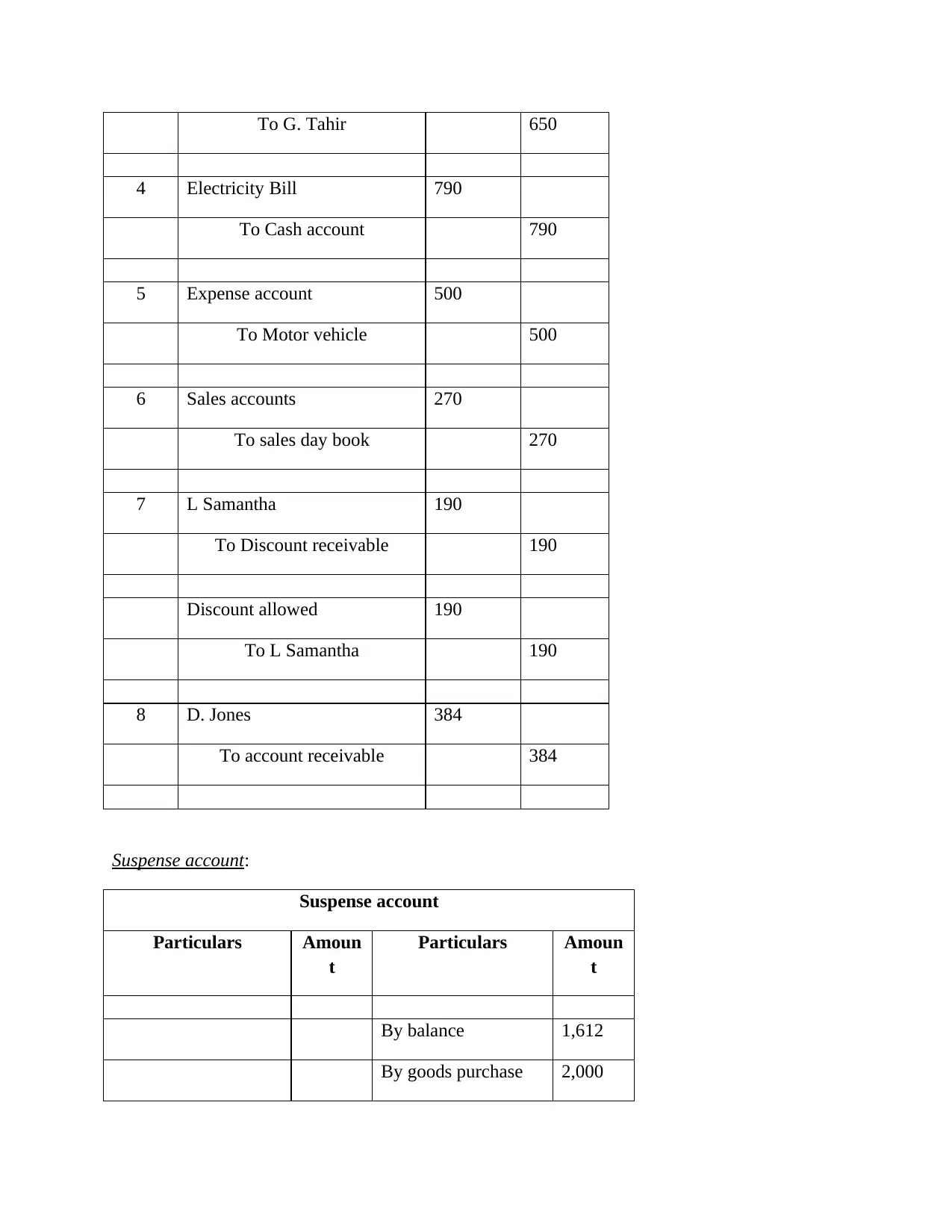
To G. Tahir 650
4 Electricity Bill 790
To Cash account 790
5 Expense account 500
To Motor vehicle 500
6 Sales accounts 270
To sales day book 270
7 L Samantha 190
To Discount receivable 190
Discount allowed 190
To L Samantha 190
8 D. Jones 384
To account receivable 384
Suspense account:
Suspense account
Particulars Amoun
t
Particulars Amoun
t
By balance 1,612
By goods purchase 2,000
4 Electricity Bill 790
To Cash account 790
5 Expense account 500
To Motor vehicle 500
6 Sales accounts 270
To sales day book 270
7 L Samantha 190
To Discount receivable 190
Discount allowed 190
To L Samantha 190
8 D. Jones 384
To account receivable 384
Suspense account:
Suspense account
Particulars Amoun
t
Particulars Amoun
t
By balance 1,612
By goods purchase 2,000
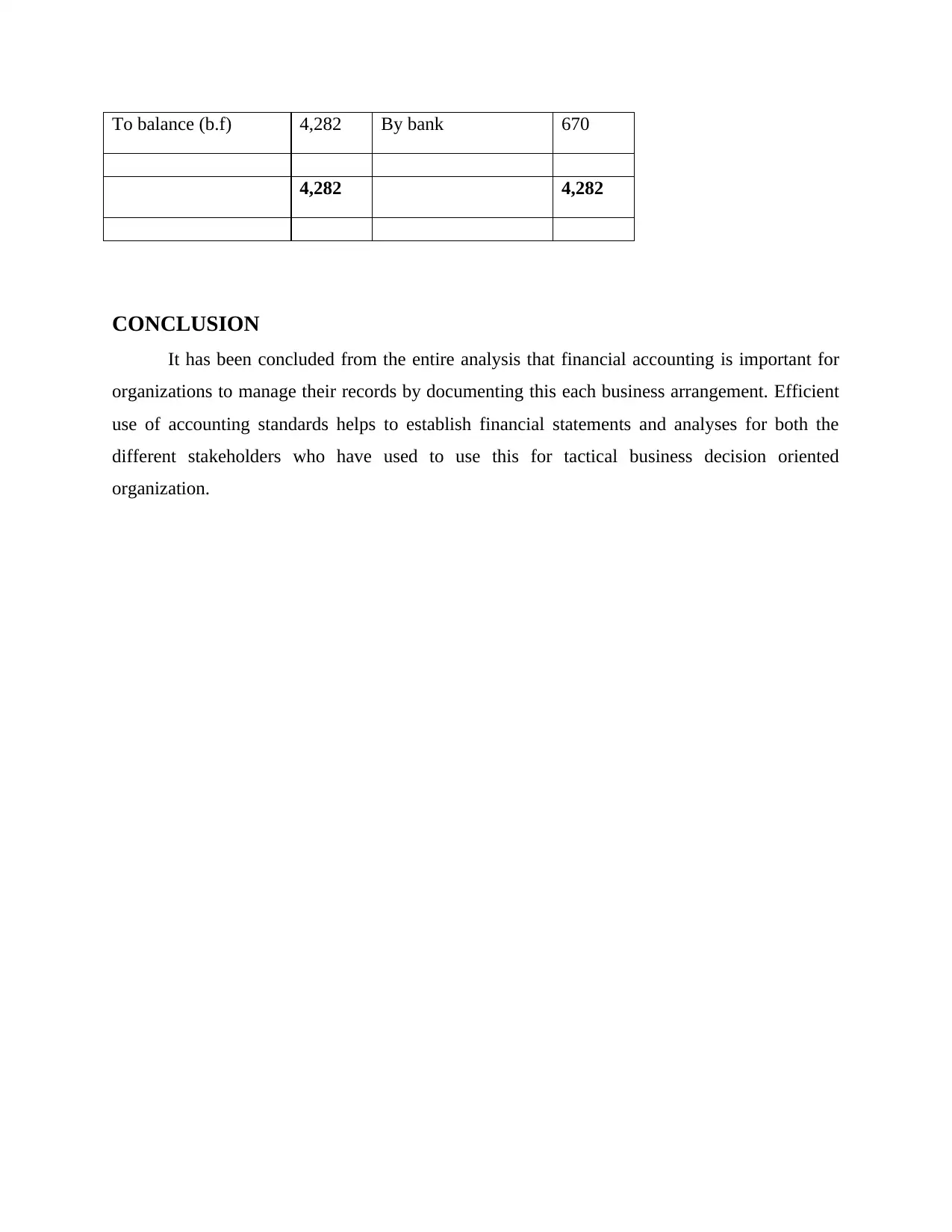
To balance (b.f) 4,282 By bank 670
4,282 4,282
CONCLUSION
It has been concluded from the entire analysis that financial accounting is important for
organizations to manage their records by documenting this each business arrangement. Efficient
use of accounting standards helps to establish financial statements and analyses for both the
different stakeholders who have used to use this for tactical business decision oriented
organization.
4,282 4,282
CONCLUSION
It has been concluded from the entire analysis that financial accounting is important for
organizations to manage their records by documenting this each business arrangement. Efficient
use of accounting standards helps to establish financial statements and analyses for both the
different stakeholders who have used to use this for tactical business decision oriented
organization.
Secure Best Marks with AI Grader
Need help grading? Try our AI Grader for instant feedback on your assignments.
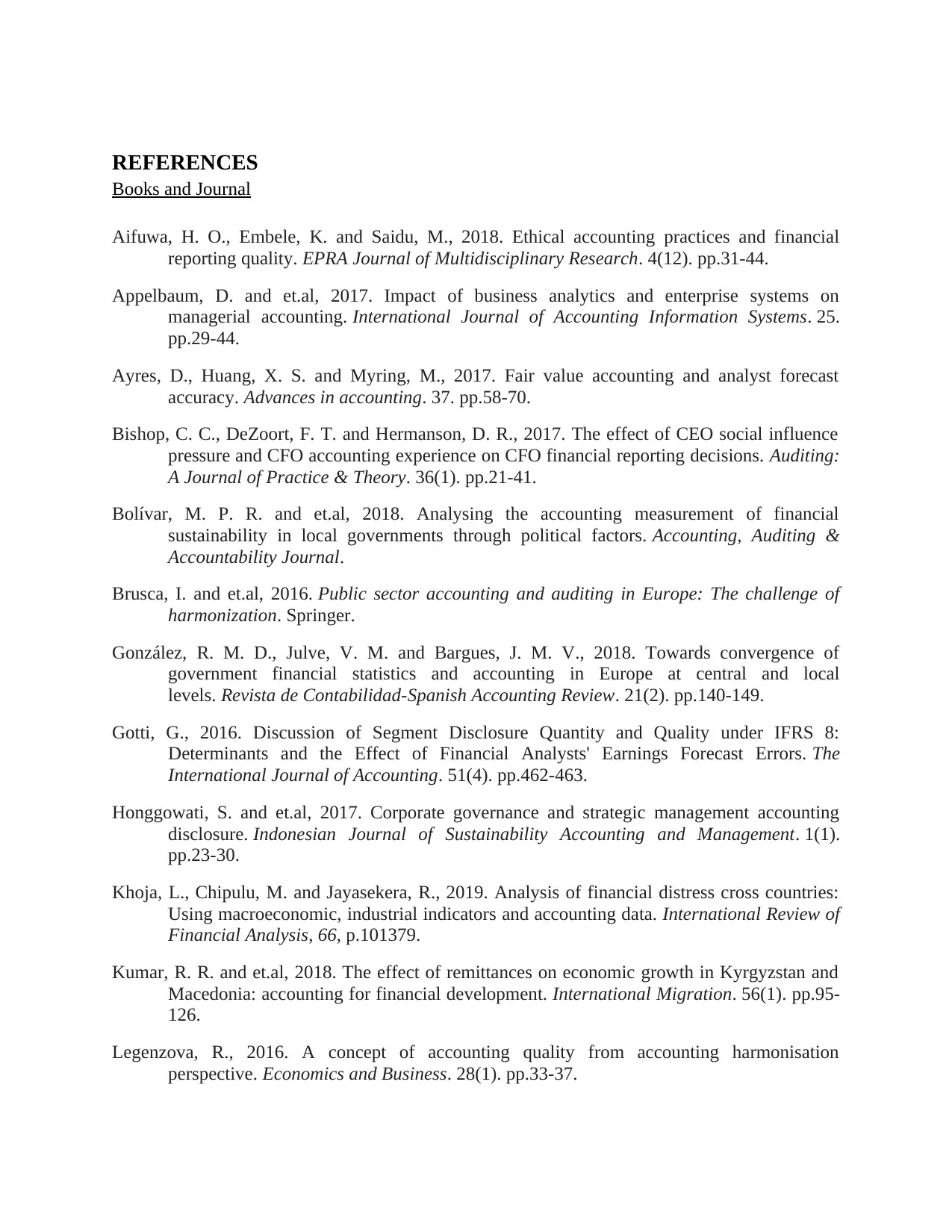
REFERENCES
Books and Journal
Aifuwa, H. O., Embele, K. and Saidu, M., 2018. Ethical accounting practices and financial
reporting quality. EPRA Journal of Multidisciplinary Research. 4(12). pp.31-44.
Appelbaum, D. and et.al, 2017. Impact of business analytics and enterprise systems on
managerial accounting. International Journal of Accounting Information Systems. 25.
pp.29-44.
Ayres, D., Huang, X. S. and Myring, M., 2017. Fair value accounting and analyst forecast
accuracy. Advances in accounting. 37. pp.58-70.
Bishop, C. C., DeZoort, F. T. and Hermanson, D. R., 2017. The effect of CEO social influence
pressure and CFO accounting experience on CFO financial reporting decisions. Auditing:
A Journal of Practice & Theory. 36(1). pp.21-41.
Bolívar, M. P. R. and et.al, 2018. Analysing the accounting measurement of financial
sustainability in local governments through political factors. Accounting, Auditing &
Accountability Journal.
Brusca, I. and et.al, 2016. Public sector accounting and auditing in Europe: The challenge of
harmonization. Springer.
González, R. M. D., Julve, V. M. and Bargues, J. M. V., 2018. Towards convergence of
government financial statistics and accounting in Europe at central and local
levels. Revista de Contabilidad-Spanish Accounting Review. 21(2). pp.140-149.
Gotti, G., 2016. Discussion of Segment Disclosure Quantity and Quality under IFRS 8:
Determinants and the Effect of Financial Analysts' Earnings Forecast Errors. The
International Journal of Accounting. 51(4). pp.462-463.
Honggowati, S. and et.al, 2017. Corporate governance and strategic management accounting
disclosure. Indonesian Journal of Sustainability Accounting and Management. 1(1).
pp.23-30.
Khoja, L., Chipulu, M. and Jayasekera, R., 2019. Analysis of financial distress cross countries:
Using macroeconomic, industrial indicators and accounting data. International Review of
Financial Analysis, 66, p.101379.
Kumar, R. R. and et.al, 2018. The effect of remittances on economic growth in Kyrgyzstan and
Macedonia: accounting for financial development. International Migration. 56(1). pp.95-
126.
Legenzova, R., 2016. A concept of accounting quality from accounting harmonisation
perspective. Economics and Business. 28(1). pp.33-37.
Books and Journal
Aifuwa, H. O., Embele, K. and Saidu, M., 2018. Ethical accounting practices and financial
reporting quality. EPRA Journal of Multidisciplinary Research. 4(12). pp.31-44.
Appelbaum, D. and et.al, 2017. Impact of business analytics and enterprise systems on
managerial accounting. International Journal of Accounting Information Systems. 25.
pp.29-44.
Ayres, D., Huang, X. S. and Myring, M., 2017. Fair value accounting and analyst forecast
accuracy. Advances in accounting. 37. pp.58-70.
Bishop, C. C., DeZoort, F. T. and Hermanson, D. R., 2017. The effect of CEO social influence
pressure and CFO accounting experience on CFO financial reporting decisions. Auditing:
A Journal of Practice & Theory. 36(1). pp.21-41.
Bolívar, M. P. R. and et.al, 2018. Analysing the accounting measurement of financial
sustainability in local governments through political factors. Accounting, Auditing &
Accountability Journal.
Brusca, I. and et.al, 2016. Public sector accounting and auditing in Europe: The challenge of
harmonization. Springer.
González, R. M. D., Julve, V. M. and Bargues, J. M. V., 2018. Towards convergence of
government financial statistics and accounting in Europe at central and local
levels. Revista de Contabilidad-Spanish Accounting Review. 21(2). pp.140-149.
Gotti, G., 2016. Discussion of Segment Disclosure Quantity and Quality under IFRS 8:
Determinants and the Effect of Financial Analysts' Earnings Forecast Errors. The
International Journal of Accounting. 51(4). pp.462-463.
Honggowati, S. and et.al, 2017. Corporate governance and strategic management accounting
disclosure. Indonesian Journal of Sustainability Accounting and Management. 1(1).
pp.23-30.
Khoja, L., Chipulu, M. and Jayasekera, R., 2019. Analysis of financial distress cross countries:
Using macroeconomic, industrial indicators and accounting data. International Review of
Financial Analysis, 66, p.101379.
Kumar, R. R. and et.al, 2018. The effect of remittances on economic growth in Kyrgyzstan and
Macedonia: accounting for financial development. International Migration. 56(1). pp.95-
126.
Legenzova, R., 2016. A concept of accounting quality from accounting harmonisation
perspective. Economics and Business. 28(1). pp.33-37.
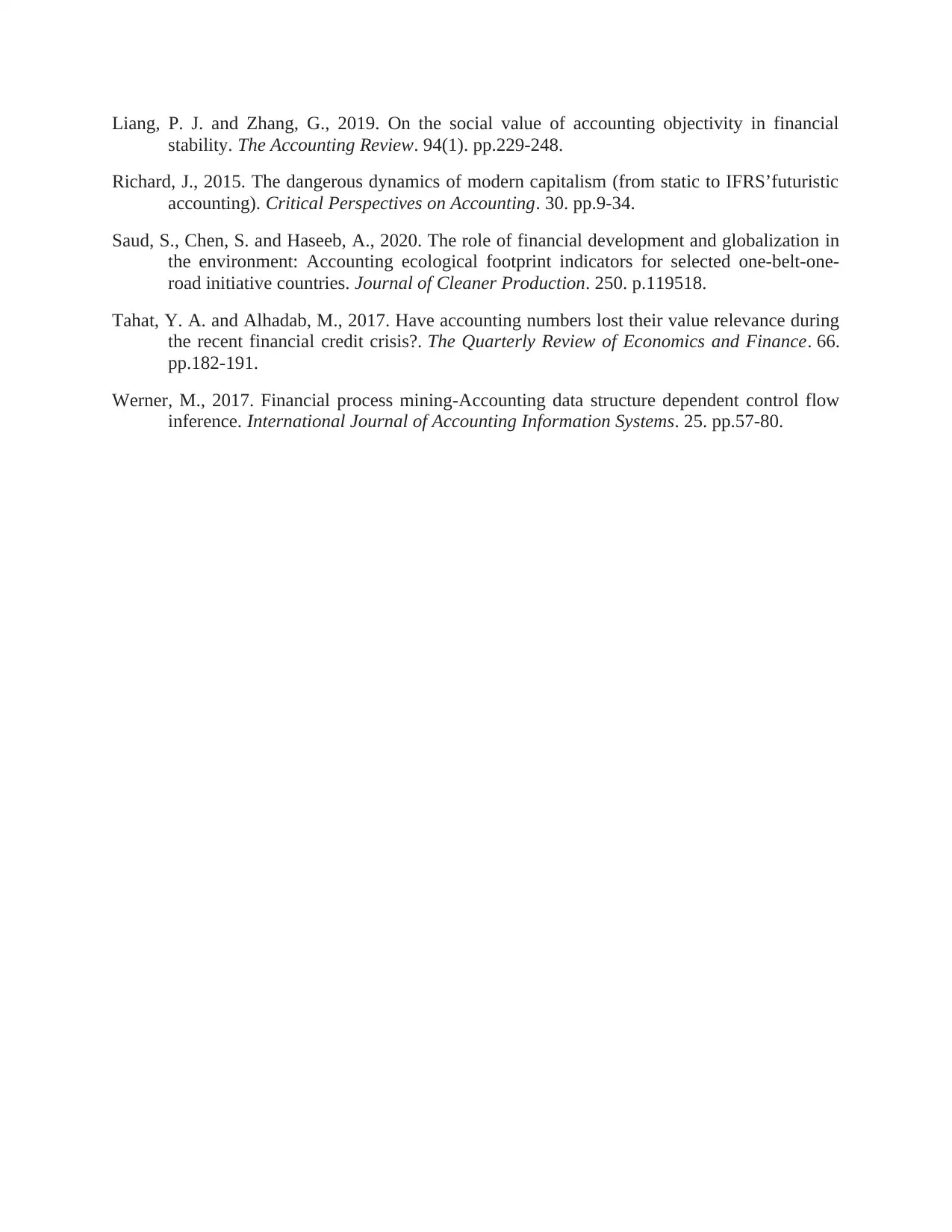
Liang, P. J. and Zhang, G., 2019. On the social value of accounting objectivity in financial
stability. The Accounting Review. 94(1). pp.229-248.
Richard, J., 2015. The dangerous dynamics of modern capitalism (from static to IFRS’futuristic
accounting). Critical Perspectives on Accounting. 30. pp.9-34.
Saud, S., Chen, S. and Haseeb, A., 2020. The role of financial development and globalization in
the environment: Accounting ecological footprint indicators for selected one-belt-one-
road initiative countries. Journal of Cleaner Production. 250. p.119518.
Tahat, Y. A. and Alhadab, M., 2017. Have accounting numbers lost their value relevance during
the recent financial credit crisis?. The Quarterly Review of Economics and Finance. 66.
pp.182-191.
Werner, M., 2017. Financial process mining-Accounting data structure dependent control flow
inference. International Journal of Accounting Information Systems. 25. pp.57-80.
stability. The Accounting Review. 94(1). pp.229-248.
Richard, J., 2015. The dangerous dynamics of modern capitalism (from static to IFRS’futuristic
accounting). Critical Perspectives on Accounting. 30. pp.9-34.
Saud, S., Chen, S. and Haseeb, A., 2020. The role of financial development and globalization in
the environment: Accounting ecological footprint indicators for selected one-belt-one-
road initiative countries. Journal of Cleaner Production. 250. p.119518.
Tahat, Y. A. and Alhadab, M., 2017. Have accounting numbers lost their value relevance during
the recent financial credit crisis?. The Quarterly Review of Economics and Finance. 66.
pp.182-191.
Werner, M., 2017. Financial process mining-Accounting data structure dependent control flow
inference. International Journal of Accounting Information Systems. 25. pp.57-80.
1 out of 24
Related Documents
Your All-in-One AI-Powered Toolkit for Academic Success.
+13062052269
info@desklib.com
Available 24*7 on WhatsApp / Email
![[object Object]](/_next/static/media/star-bottom.7253800d.svg)
Unlock your academic potential
© 2024 | Zucol Services PVT LTD | All rights reserved.





